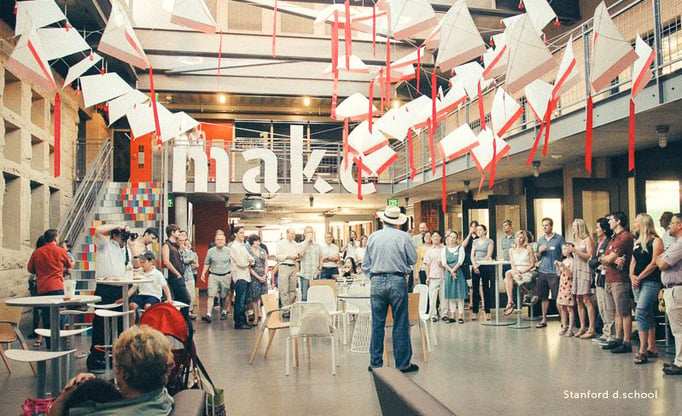The just cause in service of the beloved is what distinguishes between innovation and mere invention. SeeingAI is an invention, but the measure of its success as an innovation is whether it adds real value to people’s lives.
Innovation isn’t actually about blue-sky thinking—it’s about a relentless focus on making experiences better for people.
 Design thinking is a rigorous process for envisioning, prototyping, and bringing to life innovative products and experiences. The Stanford d.school is one of its originators and remains a titan in the industry, so we were excited to have the chance to participate in the d.school’s new design thinking workshop as it was beta-tested on campus.
Design thinking is a rigorous process for envisioning, prototyping, and bringing to life innovative products and experiences. The Stanford d.school is one of its originators and remains a titan in the industry, so we were excited to have the chance to participate in the d.school’s new design thinking workshop as it was beta-tested on campus.
We began the workshop with a deliberate exercise in empathy. Working in pairs, we first listened as our partner described the ups and downs of their day. Before touching pen to paper to create anything, we were asked to dig deeper. Our mission was to uncover where they experienced friction or pain points. We were equipped with a single diagnostic tool: the question, “Why?” Each time we asked, we got closer to the heart of the problem—and closer to our partner’s lived experience.
My partner in the workshop started by talking about an overwhelming proliferation of tasks she needed to complete to support her aging parents: shopping, cooking, doctor’s appointments, and household maintenance. She described friction in her day as she tried to ease her parents’ burdens while respecting their autonomy and handling the frustrations of memory loss.
The more we spoke, the more I understood that the pain she was experiencing wasn’t just about getting things done. The vision we were working toward wasn’t a spotless house or a checked-off to-do list. It was about time and human connection. What she really wanted was for the time she had with her parents to be meaningful. That core insight enabled us to paint a new picture of what innovation could do for her: in this picture, she sits side-by-side with her parents, having a heartfelt conversation and enjoying one another’s company. The innovation we needed was anything and everything that made that vision possible.
Empathy and focus give creativity its fuel.
The first paradox of innovation is that it demands limits. Creativity thrives on boundaries: they provide the outlines of the space in which we can freely play, explore, and invent. The discipline of asking “why” in response to each new insight in our design thinking workshop took us to deeper levels of understanding—and, in doing so,opened up new possibilities for meeting more fundamental needs in more innovative ways.
Solving the task of getting groceries home from the store opens one small array of possible interventions: perhaps grocery delivery, perhaps online shopping tools. Had we stopped there, our “innovative” brainstorming session might have ended early with a few technical hacks that slightly improved the grocery shopping experience for my partner.
But asking “why” brought us new horizons. The world of potential solutions grows wider and richer the more fully we understand the lives of the people we serve. We ended up discussing everything—seamless, connected apps to mobilize other family members to volunteer their help, accessible kitchen design, smart appliances and utilities, and memory aids. We talked about safer sidewalks and service animals. Every time we got closer to my partner’s “why,” we found new entry points for creativity and design.
Empathy can be learned and practiced.